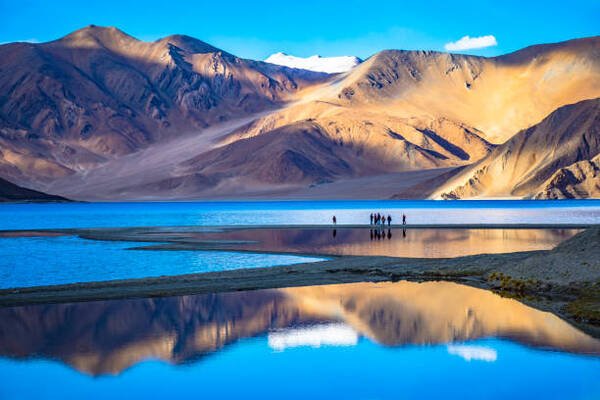Travel Guides & Articles
India Empowers Ladakh Youth As Astro Ambassadors To Ignite A New Era Of Space Tourism In The Himalayas

Monday, August 4, 2025
Ladakh’s remote landscapes are no longer just a draw for adventure seekers—they’re now becoming a beacon for global astronomy tourism, thanks to India’s bold initiative to empower local youth as Astro Ambassadors. Trained in night sky navigation and telescope operation, these young stars of Hanle are not only boosting sustainable tourism in India’s only dark sky reserve but also transforming the region’s economy and identity. By turning stargazing into a profession, they’re helping India claim its place on the map of global astro-tourism, while showcasing how rural empowerment and scientific curiosity can reshape the future of travel.
In the high-altitude wilderness of Ladakh, a new form of tourism is emerging under the brilliant canopy of stars. In the remote village of Hanle, nestled close to India’s northern frontier, a group of local youth has embraced an unusual yet captivating profession—night-time astronomy tourism. These young individuals, now known as “Astro-ambassadors,” are leading a transformative movement that fuses science, culture, and sustainable tourism.
Hanle is home to India’s first and only dark sky reserve, an officially recognized zone with minimal light pollution, making it one of the best locations in the country for stargazing. In December 2024, a 22-kilometre-wide stretch of this remote terrain was designated as the Hanle Dark Sky Reserve (HDSR). This initiative was born out of a joint effort between the Union Territory of Ladakh, the local autonomous council in Leh, and a leading national astrophysics institution. The primary goal: to protect the region’s pristine night sky while opening up new avenues for eco-conscious tourism.
Equipped with high-powered telescopes and trained in the fundamentals of astronomy, the Astro-ambassadors offer visitors an unforgettable celestial experience. Tourists who travel to this far-flung corner of India are rewarded not just with panoramic views of barren landscapes and snow-capped peaks, but also with guided night-time sessions under a sky ablaze with stars, planets, and distant galaxies. The experience is immersive, educational, and deeply inspiring, especially for those with a passion for the cosmos.
What sets this initiative apart is its strong focus on empowering local communities, especially women. Currently, 24 Astro-ambassadors are actively involved in the project, and a notable 70 percent of them are women. Their participation reflects a broader social transformation, where opportunities in science and tourism are helping bridge gender gaps in one of the country’s most isolated regions. These women, trained in astronomy and public engagement, now serve as the face of a movement that’s redefining the narrative of rural development in Ladakh.
Tourism in Ladakh has historically been centered around adventure sports, monasteries, and scenic drives across rugged mountain passes. While these continue to attract travelers, the shift toward astro-tourism represents a new chapter that emphasizes knowledge, sustainability, and ecological preservation. The dark sky reserve is more than a tourist attraction—it is a protected zone where artificial lighting is strictly regulated, helping to maintain the natural rhythm of the nocturnal ecosystem and reduce carbon footprints.
However, the need for such environmentally conscious tourism is becoming urgent. Ladakh is not just one of the most beautiful places in India—it is also one of the most vulnerable. Its cold desert environment is characterized by minimal vegetation, fragile ecosystems, and temperature extremes that can swing dramatically between day and night. In recent years, the region has seen a sharp rise in infrastructure development, including roads, hotels, and military installations. While these projects have brought connectivity and investment, they’ve also contributed to a growing environmental strain.
Climate change has begun to alter the very fabric of Ladakh’s landscape. Glacial retreat, erratic weather patterns, and water scarcity are now part of daily life in many parts of the region. Against this backdrop, the Hanle Dark Sky Reserve offers a model for how tourism can be both profitable and planet-friendly. By limiting the impact of human activity after sunset and preserving the night sky in its most natural form, the initiative demonstrates a balance between exploration and conservation.
Visitors who come to Hanle for astro-tourism often leave with more than just photographs—they carry with them a renewed sense of wonder and a deeper appreciation for the universe and Earth alike. The success of the Astro-ambassadors, many of whom come from humble backgrounds, proves that with the right training and support, local communities can lead the charge in redefining tourism for a changing world.
As the stars continue to shine over Hanle’s silent valleys, this initiative serves as a reminder that sometimes, looking up can be the most powerful way to move forward. In a region where climate challenges loom large, turning to the skies may just be the key to creating a brighter, more sustainable future on the ground.
Travel Guides & Articles
Multiple Landslides Disrupt Traffic and Prompt Travel Advisory

KOHIMA- Heavy monsoon rains lashed Nagaland on Sunday, triggering multiple landslides that disrupted traffic along both National Highway-29 (NH-29) and alternative routes, prompting authorities to issue an urgent travel advisory. While no casualties have been reported, officials have cautioned residents and travelers to remain alert as the state braces for more rain in the coming days.
In Peren district, Deputy Commissioner’s office issued a public advisory warning of several landslides along the Mhainamtsi–Pimla road, an alternate route frequently used when NH-29 is blocked. Authorities confirmed that the road is currently impassable, with debris and unstable slopes posing risks of further slides.
Meanwhile, flooding from the Chathe River triggered a major landslide near Pherima village on NH-29, the crucial highway connecting state capital Kohima to the commercial hub of Dimapur. Videos shared on social media showed massive debris covering the highway, stranding vehicles and halting movement of goods.
Emergency teams, including the State Disaster Response Force (SDRF), have been deployed for clearance and restoration work. Officials recalled that this stretch witnessed a deadly landslide in September 2024, which claimed six lives, underscoring the chronic vulnerability of the route.
The Nagaland State Disaster Management Authority (NSDMA) reiterated its warnings about landslide-prone zones in the state, urging people to avoid travel on unsafe stretches, monitor official updates, and remain vigilant in hillside villages. The India Meteorological Department (IMD) has forecast continued heavy showers for the next 48 hours, raising the risk of further landslides and flash floods.
Chief Minister Neiphiu Rio’s office assured that state resources have been mobilized, and local communities will receive support. Residents in vulnerable areas have been asked to follow NSDMA’s safety guidelines, including avoiding steep slopes, watching for unusual cracks or ground movement, and preparing for possible evacuations.
Travel Guides & Articles
Calling all thirsty Joburg agents!

Travel agents and ITCs – you are invited to the last Travel News Thirsty event of the year!
No speeches, no presentations. Just networking.
Come join us in Sandton on Wednesday, October 23, from 17h00 to 19h00.
If you are a travel agent, please email rsvp@travelnews.co.za with ‘Thirsty’ in the subject line. Attendance is by invitation only, so it’s essential to RSVP and receive confirmation.
We look forward to seeing you there!
Travel Guides & Articles
India’s next travel boom to come from tier-2 cities as Cox and Kings shifts focus from metros

With rising incomes, greater connectivity, and younger populations eager to travel abroad, towns such as Jaipur, Indore, Faridabad, and Dharamshala are seeing a surge in families planning their first international holidays. Social media influence and financing options like ‘buy now, pay later’ have further fuelled this trend, making overseas travel both aspirational and attainable.
To tap into this demand, Cox & Kings has launched new franchise outlets in Faridabad, Gurgaon, Dharamshala, Agra and Ahmedabad, with plans to expand to 200 outlets in the coming years. The company expects the upcoming festive and holiday season to accelerate this momentum as families increasingly choose international vacations over traditional domestic trips.
Also read | Shashi Tharoor says need to change perception of India not being safe for women tourists
“Tier-2 and Tier-3 India is no longer a silent segment; it is the growth engine of tomorrow’s travel market. At Cox & Kings, we are combining our 265-year legacy with modern travel expectations to serve these new-age customers. Our franchise-first approach allows us to bring curated experiences closer to their doorstep, while ensuring the reliability and trust the brand is known for,” said Karan Agarwal, Director of Cox & Kings.
Industry data supports this growing shift. Around 8.7% of India’s population holds a valid passport, and in July 2025 alone, over 1.24 million passports were issued. By the end of the year, the figure is expected to surpass 14.5 million.
First-time international visa applications rose 32% over the past year, with more than half originating from Tier-2 and Tier-3 cities. New airports, direct international routes from smaller cities, and the influence of digital content are driving this surge, with Dubai, Thailand and Singapore topping the list of destinations for first-time travellers.
Also read | How tourism in India’s land of blue mountains will get a boost soon
Cox & Kings is pursuing a phygital model, blending physical outlets with digital platforms to support first-time travellers seeking premium experiences. Whether it is destination weddings, family anniversaries, or solo adventures, demand from India’s smaller towns is reshaping the country’s outbound tourism, with the company projecting that in five years, Tier-2 and Tier-3 cities will outpace metros in producing first-time international tourists.
-

 Business2 weeks ago
Business2 weeks agoThe Guardian view on Trump and the Fed: independence is no substitute for accountability | Editorial
-
Tools & Platforms1 month ago
Building Trust in Military AI Starts with Opening the Black Box – War on the Rocks
-

 Ethics & Policy2 months ago
Ethics & Policy2 months agoSDAIA Supports Saudi Arabia’s Leadership in Shaping Global AI Ethics, Policy, and Research – وكالة الأنباء السعودية
-

 Events & Conferences4 months ago
Events & Conferences4 months agoJourney to 1000 models: Scaling Instagram’s recommendation system
-

 Jobs & Careers3 months ago
Jobs & Careers3 months agoMumbai-based Perplexity Alternative Has 60k+ Users Without Funding
-

 Podcasts & Talks2 months ago
Podcasts & Talks2 months agoHappy 4th of July! 🎆 Made with Veo 3 in Gemini
-

 Education3 months ago
Education3 months agoVEX Robotics launches AI-powered classroom robotics system
-

 Education2 months ago
Education2 months agoMacron says UK and France have duty to tackle illegal migration ‘with humanity, solidarity and firmness’ – UK politics live | Politics
-

 Podcasts & Talks2 months ago
Podcasts & Talks2 months agoOpenAI 🤝 @teamganassi
-

 Funding & Business3 months ago
Funding & Business3 months agoKayak and Expedia race to build AI travel agents that turn social posts into itineraries



















